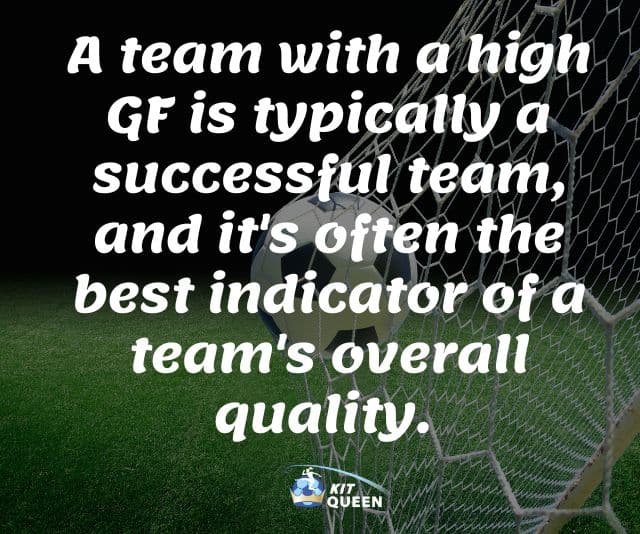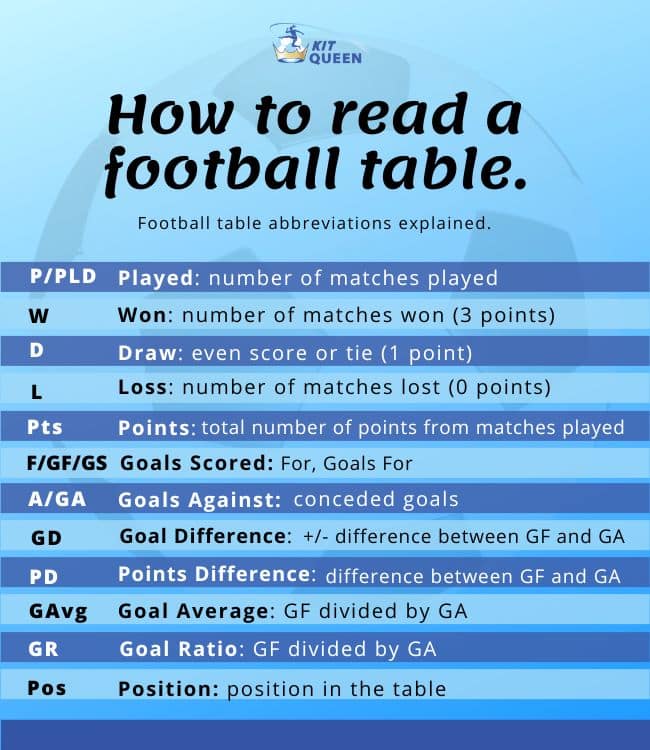Chances are, if you’re reading this, you already know the answer to ‘What does GF mean in soccer’. (It’s not Girl Friend, girlfriend!).
But just in case you don’t, or in case you want to impress your friends with your vast soccer knowledge, GF stands for “goals for.”
Basically, it’s a way to keep track of how many goals a team has scored in a game or over the course of a season.
Let’s take a dive into why GF is an important soccer stat and what it means in the grand scheme of the beautiful game.
Table of Contents
What does GF mean in soccer?
GF = Goals For
It’s used to indicate how many goals a team scores on a league table. A team with a high GF is typically a successful team, and it’s often the best indicator of a team’s overall quality.
Now that we’ve got that out of the way, let’s talk about why GF is so important.
In soccer, as in life, goals are everything.
They’re what we strive for, what we work towards, and what we look forward to celebrating with our team mates and fans.
The whole point of the game is to score more goals than your opponent. And while there are a lot of factors that contribute to whether or not a team scores a goal—from having a great goalie, to individual player skillset to team strategy—there’s no denying that having a high GF is an essential part of a successful season.
Think about it this way: let’s say two teams are evenly matched in every other aspect of their game.
The only difference is that Team A has scored 10 goals scored in their last 5 games while Team B has only scored 5. Who do you think is going to win?
Unless Team B steps up their game and starts finding the back of the net with more regularity, they’re going to have a tough time coming out on top against their higher-scoring opponents.
GF is hte opposite of GC which means goals conceded!

Why GF is so important?
So why is having a high GF so important? There are actually quite a few reasons this soccer stats stand out.
For starters, it gives you an idea of how well your team is playing overall. If you’re scoring lots of goals, it means you’re creating chances and converting them into actual match points.
On the other hand, if you’re not scoring very many goals, it could be an indication that there’s something wrong with your offense—maybe your players aren’t working well together, or maybe they’re just not skilled enough.
Either way, it’s something that needs to be addressed if you want to start winning games.
Another reason why GF is so important is because it directly correlates with winning games—and winning games is obviously the ultimate goal for any soccer team.
In most competitive leagues, the team with the most points at the end of the season (i.e., the team with the most wins) will be crowned the champs.
And while there are certainly other factors that contribute to winning games (like having a top striker or a strong defense), scoring goals is still one of the most important aspects of the game.
Finally, having a high GF can also help increase attendance at your games and generate more interest in your team from potential sponsors and investors.
Let’s face it: people like watching teams that score lots of goals!
They’re exciting to watch and tend to be more successful than teams that don’t score very often.
So it follows that teams with high GFs tend to draw larger crowds and generate more interest from potential sponsors and investors than those who don’t score as regularly.
What does GA, GD and other abbreviations mean on a league table?
GA, GS, GD, GR…when you first glance at a soccer table, it can look like a foreign language!
But with a little bit of guidance, you can quickly figure out what all the abbreviations mean. Here’s a quick debrief:

The final score.
In short,GF is important because it’s a direct indicator of how well your team is playing overall, it directly correlates with winning games, and it can help increase attendance and generate more interest from potential sponsors and investors.
So if you want your team to be successful on and off the field, start by focusing on increasing your GF!





